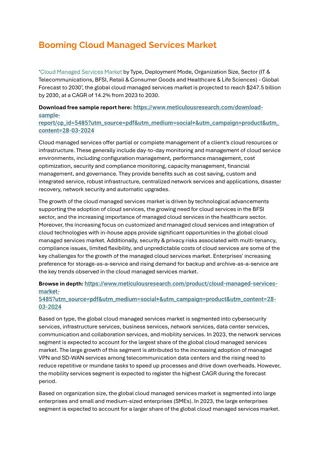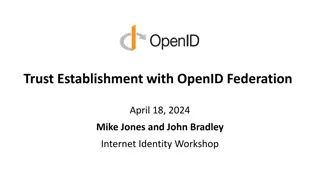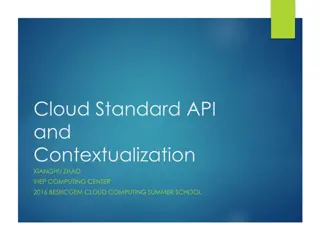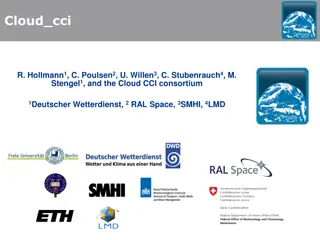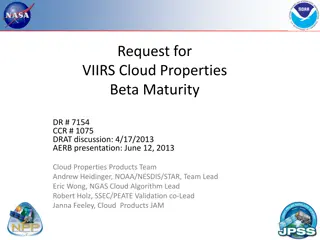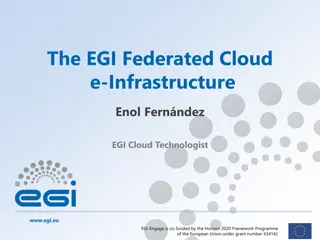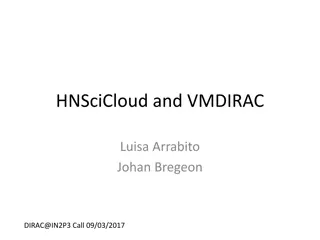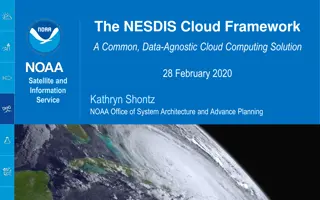Understanding Cloud Federation and Identity Management
Cloud federation involves interconnecting cloud environments to optimize resources and meet business needs. It enables providers to offer computing resources to each other, expanding geographic reach and revenue potential. With the rise of federated cloud ecosystems, protocols like XMPP play a key role in facilitating communication and standardization. Jabber XCP provides a scalable presence solution built on XMPP, ideal for enhancing applications with messaging capabilities. XMPP's decentralized and secure nature makes it a suitable protocol for cloud federation, allowing easy communication in cloud computing environments.
Download Presentation

Please find below an Image/Link to download the presentation.
The content on the website is provided AS IS for your information and personal use only. It may not be sold, licensed, or shared on other websites without obtaining consent from the author. Download presentation by click this link. If you encounter any issues during the download, it is possible that the publisher has removed the file from their server.
E N D
Presentation Transcript
Federation, Presence, Identity and Privacy in the Cloud
Cloud Federation Cloud federation is the practice of interconnecting service providers' cloud environments to load balance traffic and accommodate demand. spikes in A federated cloud (also called cloud federation) is the deployment and management of multiple external and internal cloud computing services to match business needs. A federation is the union of several smaller parts that perform a common action.
Cloud Federation Cloud wholesale or rent computing resources to another cloud provider. Those temporary or permanent extension of the buyer's cloud computing environment, depending on the specific federation agreement between providers. Cloud federation offers two substantial benefits to cloud providers. First, it allows providers to earn revenue from computing resources that would otherwise be idle or underutilized. Second, cloud federation enables cloud providers to expand their geographic footprints and accommodate sudden federation requires one provider to resources become a
Cloud Federation A key opportunity for the emerging cloud industry will be in defining a federated cloud ecosystem by connecting multiple cloud computing providers using a common standard. protocols currently used by a wide range of existing services providers 1. Internet Engineering Task Force (IETF) standard Extensible Messaging and Presence Protocol (XMPP)
Jabber XCP Jabber XCP is a highly scalable,extensible, available, and device-agnostic presence solution built on XMPP. It supports multiple protocols such as Session Initiation Protocol for Instant Messaging and Presence Leveraging Extensions (SIMPLE) and Instant Messaging and Presence Service (IMPS). Jabber XCP is a highly programmable platform, which makes it ideal for adding presence and messaging to existing applications or services and for building next-generation, presence-based solutions.
XMPP Protocol for Cloud Federation It is decentralized, meaning anyone may set up an XMPP server.It is based on open standards. It is mature multiple implementations of clients and servers exist. Robust security is supported via Simple Authentication and Security Layer (SASL) and Transport Layer Security (TLS).It is flexible and designed to be extended.
XMPP Protocol for Cloud Federation XMPP is a good fit for cloud computing because it allows for easy twoway communication;It eliminates the need for polling; It has rich publishsubscribe (pub-sub) functionality built in;It is XML-based and easily extensible, perfect for both new IM features and custom cloud services; It is efficient and has been proven to scale to millions of concurrent users on a single service (such as Google s GTalk); It also has a built-in worldwide federation model.
Levels of Federation There are at least four basic types of federation based on the ability of two XMPP servers in different domains to exchange XML stanzas. Permissive federation Verified federation. Encrypted federation. Trusted federation.
Permissive federation .Permissive federation occurs when a server accepts a connection from a peer network server without verifying its identity using DNS lookups or certificate checking. The lack of verification or authentication may lead to domain spoofing
Verified federation. This type of federation occurs when a server accepts a connection from a peer after the identity of the peer has been verified. It uses information obtained via DNS and by means of domain-specific keys exchanged beforehand. The connection is not
Encrypted federation In Encrypted federation mode, a server accepts a connection from a peer if and only if the peer supports Transport Layer Security (TLS) as defined for XMPP in Request for Comments (RFC) 3920. The peer must present a digital certificate. The certificate may be self-signed, but this prevents using mutual authentication. The certificate may be self signed(prevents mutual authentication.
Trusted federation Here, a server accepts a connection from a peer only under the stipulation that the peer supports TLS and the peer can present a digital certificate issued by a root certification authority (CA) that is trusted by the authenticating server. The list of trusted root CAs may be determined by one or more factors, such as the operating system, XMPP server software, or local service policy. In trusted federation, the use of digital certificates results not only in a channel encryption but also in strong authentication.
How Encrypted Federation Differs from Trusted Federation Verified federation serves as a foundation for encrypted federation, which builds on it concepts by requiring use of TLS for channel encryption. The Secure Sockets Layer (SSL) technology, originally developed for secure communications over HTTP, has evolved into TLS.
XMPP uses a TLS profile that enables two entities to upgrade a connection from unencrypted to encrypted. This is different from SSL in that it does not require that a separate port be used to establish secure communications. Since XMPP S2S communication uses two connections (bi- directionally connected), encrypted federation requires each entity to present a digital certificate to the reciprocating party.
Presence in the Cloud At the most fundamental level, understanding presence is simple It provides true-or-false answers to queries about the network availability of a person, device, or application. Presence is a core component of an entity s Real-time identity. Presence serves as a catalyst for communication.
Presence Protocols Standard presence protocol, SIMPLE or XMPP, is is an instant messaging and presence protocol suite based on SIP and managed by the Internet Engineering Task Force (IETF).The modern, reliable method to determine another entity s capabilities is called service discovery, wherein applications and devices exchange information about their capabilities directly, without human involvement. Even though no framework for service discovery has been produced by a standards development organization such as the IETF, a capabilities extension for SIP/SIMPLE and a robust, stable service discovery extension for XMPP does exist.
Presence Engine Providing presence data through as many avenues as possible is in large measure the responsibility of a presence engine. The presence engine acts as a broker for presence publishers and subscribers. As presence becomes more prevalent in Internet communications, presence engines need to provide strong authentication, channel encryption, explicit authorization and access control policies, high reliability, and the consistent application of aggregation rules.
Presence Engine Presence Engine should be able to operate using multiple protocols such as IMPS, SIMPLE, and XMPP. It is a basic requirement in order to distribute presence information as widely as possible. Aggregating information from a wide variety of sources requires presence rules that enable subscribers to get the right information at the right time.
The Interrelation of Identity, Presence, and Location in the Cloud Identity, presence, and location are three characteristics that lie at the core of some of the most critical emerging technologies in the market today: real-time communications (including VoIP, IM, and mobile communications), cloud computing, collaboration, and identity-based security.
The Interrelation of Identity, Presence, and Location in the Cloud Digital identity refers to the traits, attributes, and preferences on which one may receive personalized services. Identity traits might include government issued IDs, corporate user accounts, and biometric information. Two user attributes which may be associated with identity are presence and location. standards-based services for identity
Federated Identity Management Network identity is a set of attributes which describes an individual in the digital space. Identity management is the business processes and technologies of managing the life cycle of an identity and its relationship to business applications and services.
Federated Identity Management Federated identity management (IdM) refers to standards-based approaches for handling authentication, single sign-on (SSO, a property of access control for multiple related but independent(S/W systems), role-based access control, and session management across diverse organizations, security domains, and application platforms.The most widely implemented federated IdM/SSO protocol
Federating Identity Identity federation standards describe two operational roles in an Internet SSO transaction: the identity provider (IdP) andthe service provider (SP). An IdP, for ex:, might be an enterprise that manages accounts for a large number of users who may need secure Internet access to the webbased applications or services of customers, suppliers, and businesspartners. An SP might be a SaaS or a business-process outsourcing (BPO) vendor wanting to simplify client access to its services.
Federating Identity There are four common methods to achieve identity federation: Use proprietary solutions Use open source solutions Contract a vendor to do it Implement a standards based federated solution.
Identity-as-a-Service (IaaS) Identity-as-a-Service essentially leverages the SaaS model to solve the identity problem and provides for single sign-on for web applications, strong authentication, federation across boundaries, integration with internal identities and identity monitoring, compliance and management tools and services as appropriate. The more services you use in the cloud, the more you need IaaS, which should also includes elements of governance, risk management, and compliance (GRC) as part of the service.
Privacy and Its Relation to Cloud Based Information Systems Information privacy or data privacy is the relationship between collection and dissemination of data, technology, the public expectation of privacy, and the legal issues surrounding them. The challenge in data privacy is to share data while protecting personally identifiable information. Personally identifiable information (PII), as used in information security, refers to information that can be used to uniquely identify, contact, or locate a single person or can be used with other sources to uniquely identify a single individual
Privacy and Its Relation to Cloud Based Information Systems Privacy is an important business issue focused on ensuring that personal data is protected from unauthorized and inappropriate collection, use, and disclosure, ultimately preventing the loss of customer trust and inappropriate fraudulent activity such as identity theft, email spamming, and phishing.
Privacy Acts Many countries have enacted laws to protect individuals right to have their privacy respected. Canada s Personal Information Protection and Electronic Documents Act (PIPEDA) European Commission s directive on data privacy Swiss Federal Data Protection Act (DPA) and Swiss Federal Data Protection Ordinance United States, Health Insurance Portability and Accountability Act (HIPAA), The Gramm-Leach-Bliley Act (GLBA), and the FCC Customer Proprietary Network Information (CPNI) rules.
Types of Customer Information Customer information may be user data and/or personal data. User data includes Any data that is collected directly from a customer (e.g., entered by the customer via an application s user interface) Any data about a customer that is gathered indirectly (e.g., metadata in documents)
Types of Customer Information Personal data (sometimes also called personally identifiable information) includes Contact information (name, email address, phone, postal address) Forms of identification (Social Security number, driver s license, passport, fingerprints) Demographic information (age, gender, ethnicity, religious affiliation, criminal record)Occupational information (job title, company name, industry) Health care information (plans, providers, history, insurance, genetic information)





